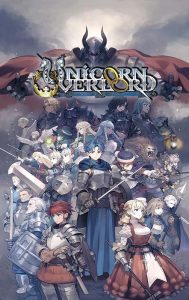Unicorn Overlord
(available on PlayStation 5, Xbox Series X & S, Nintendo Switch, and PC. Nintendo Switch used for this review)
Unicorn Overlord is from one of my current favourite developers, Vanillaware, who did a game I previously reviewed; 13 Sentinels: Aegis Rim, which I thought was excellent. They once again have teamed up with Atlas Publishing, and have moved into making a strategy RPG, with a story centring around a young prince named Alain, whose mother was betrayed several years ago by her captain of the guard, who took control of the entire kingdom and has now become the de facto world ruler. Alain now leads a liberation army that is basically made up of his friends and confidants who are rescued from being brainwashed at different points in the game.
This game has been a big part of recent Nintendo Directs, and I got a bit of a head start because I played the demo which allowed you to play the first six hours of this game.
Unicorn Overlord is very versatile in how you play it, you’re allowed to skip certain segments of the game, I was able through certain side missions to reach the final of five kingdoms. The game gives you plenty of options of what to do, for example, after a couple of side missions and building a bridge to a certain area, I found that you can skip forward to the final mission if you wish. You really shouldn’t because you’ll be severely underleveled, but the option is there.
You won’t be controlling individual characters like in Final Fantasy Tactics, you’ll be creating units with several recruited characters, and outside of story missions you can recruit mercenaries at fortresses- don’t bother, I did it a few times to fill out certain groups when I wasn’t able to have new characters to add to these upgraded formations, it’s not necessary. You get characters with much better abilities as the story progresses.
Unlike something like Final Fantasy Tactics, the gameplay is in real time, so you have to take character’s speed and environmental versatility into account when making decisions, and it also makes characters pair up with each other. The game is surprisingly customisable for how you organise character abilities. You can change how characters prioritise their abilities in certain combat situations, for example Alain gets an ability that is good against horse-mounted units, so you can change his abilities to only be used then.
PROS
- Gameplay
The combat is excellent. For the various reasons I’ve described, it makes for a very engaging experience. I did have to restart a couple of battles because I made mistakes, and you also have to take positioning into account. The leader of each unit will affect not only movement speed but abilities. If you put an archer as a leader of a unit, they can provide extra support in battle by gaining a bit of extra damage before a battle starts.
You do have to take into account a few extra aspects, for example, if you did use an archer or a healer for a pre or post combat advantage it can actually turn into a disadvantage, depending on the way that those units do damage. The game actually gives you a damage calculator in case you want to swap which units will be involved in an attack, and on some occasions using a ranged unit as aid actually decreased the amount of damage that I would do. It also costs them one of their action pieces, so unless you get them into a lookout tower, you can’t spam it, hence why it’s a good idea to get those units with ranged abilities like magic, healing, and arrows, into those areas to increase the range of that ability.
I also like the way that levelling up works. You do get it through experience, but if you want to improve a character’s class or the unit size, it requires what is known as Honours to be obtained. You gain these through beating characters in the overworld as well as doing well in story and side missions, as well as doing actions like refurbishing towns or improving the rapport of certain characters, which is often increased by having characters having a meal together in various taverns or having them fight side by side. You can definitely see where the Fire Emblem influence is here, especially considering that there are three ranks to the character’s different conversation abilities. Though obviously not every character can interact with one another in this way, only Alain has access to every single character, and this does play a part if you want to get the best possible ending, through doing the side quests that are centred around the game’s namesake.
The thing that really innovated for me was the real time aspect, since I had to really think about the positioning this time around, and which characters to have in which towns. You really have to make sure you’re levelling up everyone, so take some time to do some grinding if you need to, since this is a challenging game.
- Visuals
If you’ve seen 13 Sentinels, you know that Vanillaware can make beautiful looking games, and this is no different. While you may want to skip the combat animations, I would urge you to watch them at least whenever you get a new character because they look so good. I will admit that the combat animations can drag out some of the fights, but overall, I thought the game looked and played excellent. I was surprised how well they created so many different environments that had many different effects.
MIXED
- Story
The story isn’t bad, but it’s very basic- which surprised me because the storyline in 13 Sentinels was amazing. This is probably because gameplay was a bigger focus for the developers in this game. The thing about this story is that while it’s nowhere near complex despite the fact they tried to do a few surprises way too late into the game, the thing that it succeeds in is the characters. While the rapport conversations can be very mixed, some of them are genuinely very interesting, and it’s why I chose to recruit pretty much everyone no matter how bad they had been.
So, while those character moments are very good, I think they only serve as a very basic story which doesn’t really do too much to push the boat out.
CONS
- Boss Fights
Like most strategy RPGs, the boss fights are usually a bit of a puzzle- you have to figure out how to get extra damage. Here’s the thing though, for the life of me I couldn’t figure out some of these! I swear I just got lucky at some point and hit the winning button. Thankfully, the boss fights are minimal, you’ll only encounter a few of them throughout the game, but only in the final one was I able to use my intuition to figure out what the right answer was. They definitely drag some of the missions down.
FINAL THOUGHTS
Unicorn Overlord is a fantastic experience. If you’re not into strategy RPGs, I don’t think that this one will change your mind, and I don’t think that the storyline is that great, but overall, I would say that this game is challenging but not unfair. It’s a very good experience. Though I freely admit that the combat animations, while great, do drag out some of the fights and I was forced to press the skip button after a while, since they don’t help with the tedium.
But as a whole, it’s brilliant. It looks great, plays great, and I think it’s fantastic. I just wish the story was a little bit more interesting.
FINAL SCORE: 9/10
Director of Axia ASD Ltd.
Self-proclaimed Nerd Consultant
and Head of Axia’s Film Society.
Share This Post:








Leave a Reply